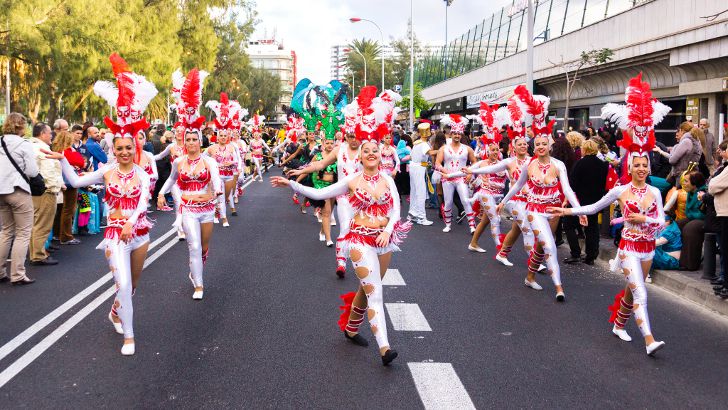The history of the Las Palmas de Gran Canaria Carnival arguably dates back to the 15th century. The first traditional parade featuring allegorical floats and carriages accompanied by revelers took place in the mid-19th century due to the emergence of various sociocultural institutions that helped to organize it. The carnival in its modern form was established in 1976 and has since become one of the most anticipated cultural events on the island and a major tourist attraction.
The carnival season on Grand Canaria begins three weeks before Ash Wednesday (the first day of Lent in Western Christianity). Numerous parties, galas, contests, children’s events, concerts, shows and parades are held across the city of Las Palmas, transforming it into the carnival capital of the Canary Islands.
One of the carnival’s main highlights is the Queen Gala. Every year a new Queen of the Carnival is selected from among the contestants. All contenders wear beautiful and unique outfits designed and made by renowned fashion designers. The Queen Gala is a spectacular event featuring a beauty pageant and live performances on the main stage of the festival, it attracts about 4,000 spectators every year. The woman crowned as Queen of the Carnival becomes the official representative of the next edition of the Carnival of Las Palmas de Gran Canaria.
The Drag Queen Gala is another major attraction regarded as one of the Carnival’s most high-profile events. It was established in 1998 and has since become one of the Carnival’s signature events. There are so many candidates every year that a qualifying contest is held in order to choose the finalists. The Drag Queen Gala is the embodiment of the Carnival in its purest state with all kinds of live entertainment, a total lack of inhibition and defying gender norms.
The main event of the Las Palmas de Gran Canaria Carnival is the Grand Parade held on the Saturday before Ash Wednesday. The parade is led by both Queens of the Carnival accompanied by murga groups and comparsas. Murga is a form of musical theater performed in Spanish-speaking countries during the Carnival season. It originated in Uruguay. Comparsas are groups of singers, musicians and dancers similar to Brazilian carnival blocks or New Orleans style krewes. The parade walks a six kilometer route across Las Palmas, attracting some 200,000 spectators.
The carnival concludes with the Sardine’s Funeral that takes place on the Sunday following the Grand Parade. A big parade crosses the city before arriving at Lan Canteras Beach where revelers burn a huge sardine that symbolizes the spirit of the Carnival. The burning is followed by a fireworks display.

Photo by mike.bulter




